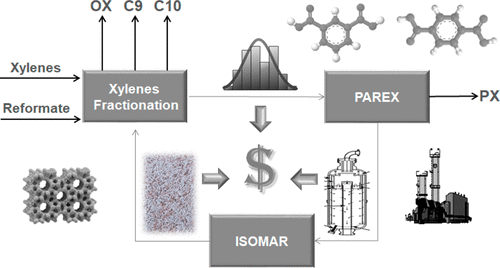当前位置:
X-MOL 学术
›
Ind. Eng. Chem. Res.
›
论文详情
Our official English website, www.x-mol.net, welcomes your
feedback! (Note: you will need to create a separate account there.)
Xylene Isomerization Unit Catalyst Deactivation: Quantitative Case Study of an Industrial Unit
Industrial & Engineering Chemistry Research ( IF 3.8 ) Pub Date : 2018-12-06 , DOI: 10.1021/acs.iecr.8b04601 Wanessa B. Costa 1 , Carlos A. Pires 2
Industrial & Engineering Chemistry Research ( IF 3.8 ) Pub Date : 2018-12-06 , DOI: 10.1021/acs.iecr.8b04601 Wanessa B. Costa 1 , Carlos A. Pires 2
Affiliation

|
The isomerization of xylenes is a catalytic transformation process of metaxylene and ethylbenzene, which aims to restore the balance between both isomers and convert the ethylbenzene to xylenes. The knowledge of the catalytic deactivation behavior between stages of operation or campaigns (catalyst that has undergone successive regenerations and activations) in xylenes isomerization is very important to determine the useful life of the catalyst and, consequently, to improve the estimation of the economic viability to operate the unit, whether with a new or an old kind of catalyst. This work is a preliminary case study of catalyst deactivation, focused on pre-existing industrial data production of xylenes from a unit found in a famous industry known as Braskem, which is located in Brazil. This article involves monitoring a catalyst load throughout its useful life, which has gone through seven consecutive campaigns. The first stage of the work involved the definition of the variables that most influenced the ethylbenzene conversion and the proposition of two mathematical models, one linear and another quadratic, whose parameters were found from real plant data. The quadratic model best represented the actual behavior of the system, and the methodology used led to the conclusion that the analysis of the real ethylbenzene conversion data between the campaigns would not be sufficient to elucidate the catalyst deactivation profile due to the variability of operating conditions between the different campaigns. The catalyst irreversible activity losses (deactivation rates) between the campaigns were calculated from the quadratic models, to determine the variation of the conversion between the campaigns. Finally, an economic evaluation was done with the aim of evaluating the optimal catalyst lifetime.
中文翻译:

二甲苯异构化单元催化剂失活:工业单元的定量案例研究
二甲苯的异构化是间二甲苯和乙苯的催化转化过程,旨在恢复两种异构体之间的平衡并将乙苯转化为二甲苯。在二甲苯异构化过程中,在操作或运行阶段(经过连续再生和活化的催化剂)之间催化失活行为的知识对于确定催化剂的使用寿命非常重要,因此对于提高对催化剂的经济可行性的估计也非常重要。使用新催化剂或旧催化剂操作该装置。这项工作是对催化剂失活的初步案例研究,其重点是从位于巴西的著名工业Braskem中发现的单元中,预先存在二甲苯的工业数据生产。本文涉及监视催化剂负载的整个使用寿命,该负载已经经历了七个连续的活动。工作的第一阶段涉及对乙苯转化率影响最大的变量的定义,以及提出两个数学模型的建议,一个是线性模型,另一个是二次模型,这些模型的参数是从真实的工厂数据中找到的。二次模型最能代表系统的实际行为,所使用的方法得出的结论是,由于两次反应之间的操作条件存在差异,对两次运动之间的实际乙苯转化数据进行分析将不足以阐明催化剂的失活曲线。不同的运动。通过二次模型计算出各次运动之间催化剂不可逆的活性损失(失活率),确定广告系列之间转化的差异。最后,进行了经济评估,目的是评估最佳催化剂寿命。
更新日期:2018-12-07
中文翻译:

二甲苯异构化单元催化剂失活:工业单元的定量案例研究
二甲苯的异构化是间二甲苯和乙苯的催化转化过程,旨在恢复两种异构体之间的平衡并将乙苯转化为二甲苯。在二甲苯异构化过程中,在操作或运行阶段(经过连续再生和活化的催化剂)之间催化失活行为的知识对于确定催化剂的使用寿命非常重要,因此对于提高对催化剂的经济可行性的估计也非常重要。使用新催化剂或旧催化剂操作该装置。这项工作是对催化剂失活的初步案例研究,其重点是从位于巴西的著名工业Braskem中发现的单元中,预先存在二甲苯的工业数据生产。本文涉及监视催化剂负载的整个使用寿命,该负载已经经历了七个连续的活动。工作的第一阶段涉及对乙苯转化率影响最大的变量的定义,以及提出两个数学模型的建议,一个是线性模型,另一个是二次模型,这些模型的参数是从真实的工厂数据中找到的。二次模型最能代表系统的实际行为,所使用的方法得出的结论是,由于两次反应之间的操作条件存在差异,对两次运动之间的实际乙苯转化数据进行分析将不足以阐明催化剂的失活曲线。不同的运动。通过二次模型计算出各次运动之间催化剂不可逆的活性损失(失活率),确定广告系列之间转化的差异。最后,进行了经济评估,目的是评估最佳催化剂寿命。


















































 京公网安备 11010802027423号
京公网安备 11010802027423号